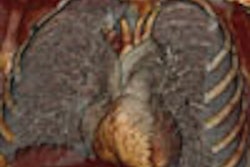CHICAGO - Diverticular disease, the result of poor eating habits among the world's wealthiest citizens, may affect as many as a third of asymptomatic adults over 50 in Western nations, and as many as two-thirds of those over 80.
Thus the disease affects colorectal cancer screening as well -- as the major cause of failed optical colonoscopy, and an important source of interpretive errors in virtual colonoscopy. With few screening options left, patients with severe diverticular disease are sometimes relegated to the double-contrast barium enema, which can miss as many as half of their clinically significant polyps.
But virtual colonoscopy needn't fail these patients. Researchers in Wisconsin found that moderate or severe diverticular disease didn't degrade VC's diagnostic performance when the segments were examined using 3D endoluminal views correlated with 2D MPR views. In fact, VC did slightly better in affected colon segments.
Yesterday at the RSNA meeting's VC sessions, Dr. Matthew Sanford from the University of Wisconsin in Madison presented a retrospective study of 288 patients with suspected diverticular disease (167 men, 113 women; mean age 58.1) who were part of the larger U.S. Department of Defense multicenter trial, which examined 1,192 asymptomatic patients (New England Journal of Medicine, December 4, 2003, Vol. 349:23, pp. 2191-2120).
"First, diverticular disease is a common cause of failed optical colonoscopy, and second, a similar result is seen in VC … in our experience with over 3,000 screening patients," said Sanford, who performed the study with his UW colleagues including Dr. Perry Pickhardt. "Our primary goal was to evaluate the impact of diverticular disease on the diagnostic performance of primary 3D VC," he said.
All 280 patients had undergone virtual colonoscopy with MDCT following cathartic bowel cleansing and self-administered room-air insufflation, examined on a V3D Colon workstation (Viatronix, Stony Brook, NY). The polyps were confirmed by same-day colonoscopy utilizing a standard polyp-matching scheme. The data were reexamined on a Viatronix workstation for this study.
"We were surprised to find that these patients averaged less than 60 and three-fourths had some evidence of diverticular disease; two-thirds had had moderate or extensive disease," defined for the study as significant luminal narrowing, Haustral fold thickening and thickening of the colon wall, Sanford said. Those parenthetically labeled as having extensive disease had "more than the simple spasm that would persist on both prone and supine images," he said.
Each of eight colonic segments in each patient was categorized as mild, moderate, severe, or absent colonic diverticular disease, and read by experienced radiologists who were blinded to the previous results.
According to the results, 271 of 2,240 total colonic segments (12.1%) were deemed to have significant diverticular disease. The sigmoid colon accounted for nearly half (139/280, 49.6%) of these segments; the descending colon was the next most significant source.
By segment VC performance in terms of sensitivity, specificity, and positive and negative predictive values for the detection of polyps 6 mm and larger was 90.3% (28/31), 79.4% (123/155), 97.1% (233/240), and 97% (1,772/1,814), and 80% (28/35), 74.5% (123/165), 98.7% (233/236), and 98.2% (1,772/1,804), respectively (p = 0.15-0.18).
Also, there were more polyps 6 mm and larger in segments with significant diverticular disease compared to other segments (11.4%, 31/271 versus 7.9%, 155/1,969). In segments with significant luminal narrowing and fold thickening there were 28 true positives and three false negatives undetected by VC.
"Although the p value was 0.15, sensitivity was slightly higher in segments with moderate or extensive disease," Sanford said. "Specificity and predictive values were comparable between the two groups, and this was surprising to us as well. We thought that if anything as the folds thickened and the lumen became more narrow in patients with diverticular disease, there would be more false positives as well as more true mucosal lesions…. Note, too, that the presence of diverticular disease parallels that of colorectal neoplasia."
The presence of diverticular disease did not degrade the performance of VC -- less than 1% of patients had nondiagnostic segments at VC, he concluded. Moreover, VC's sensitivity was slightly higher in affected segments.
"In our 3,000 (UW screening patients), we've had excellent success with automated CO2 insufflation, and we're fortunate to have a great corps of well-trained technologists … who are trained to look at prone and supine images," Sanford said.
By Eric Barnes
AuntMinnie.com staff writer
November 28, 2005
Related Reading
VC practice thrives in Wisconsin, May 5, 2005
HMO pays for screening virtual colonoscopy, June 4, 2004
VC fares better as its own gold standard, September 8, 2004
Group credits 3-D reading for best-ever VC results, October 15, 2003
Copyright © 2005 AuntMinnie.com




















